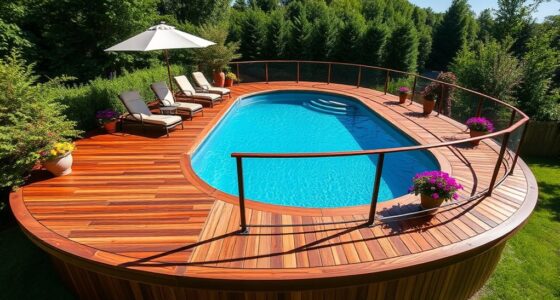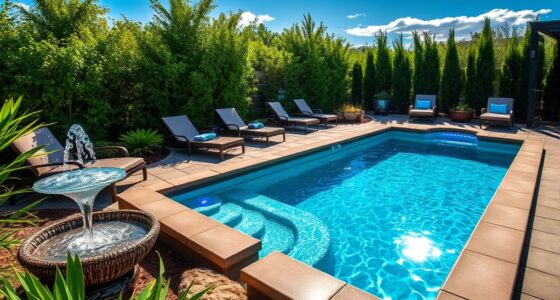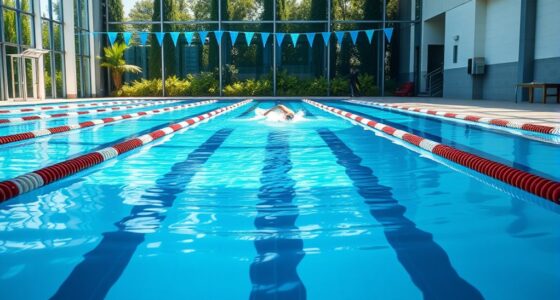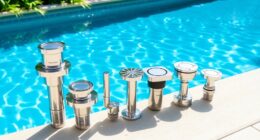When exploring top natural swimming pool concepts, consider designs that blend seamlessly with your garden landscape. Choose between one-pot or two-pot systems, featuring native plants for efficient filtration and wildlife support. Incorporate natural materials like wood and boulders to enhance aesthetics while promoting ecological balance. Don’t forget maintenance tips like regular cleaning to prevent algae blooms. Continue to discover innovative ideas that make your natural pool a stunning and sustainable oasis.
Key Takeaways
- One-pot and two-pot designs offer flexibility, with regeneration zones enhancing aesthetics and water quality in natural swimming pools.
- Incorporating native aquatic plants enhances adaptability and promotes effective nutrient removal, supporting a healthy ecosystem.
- Blending natural swimming pools with lush landscaping creates a seamless integration that fosters ecological balance and vibrancy.
- Biological filtration systems minimize chemical use, protecting local wildlife while improving water quality and reducing maintenance needs.
- Customizable designs allow for unique adaptations that cater to individual landscapes, enhancing both beauty and functionality.
Benefits of Choosing a Natural Swimming Pool
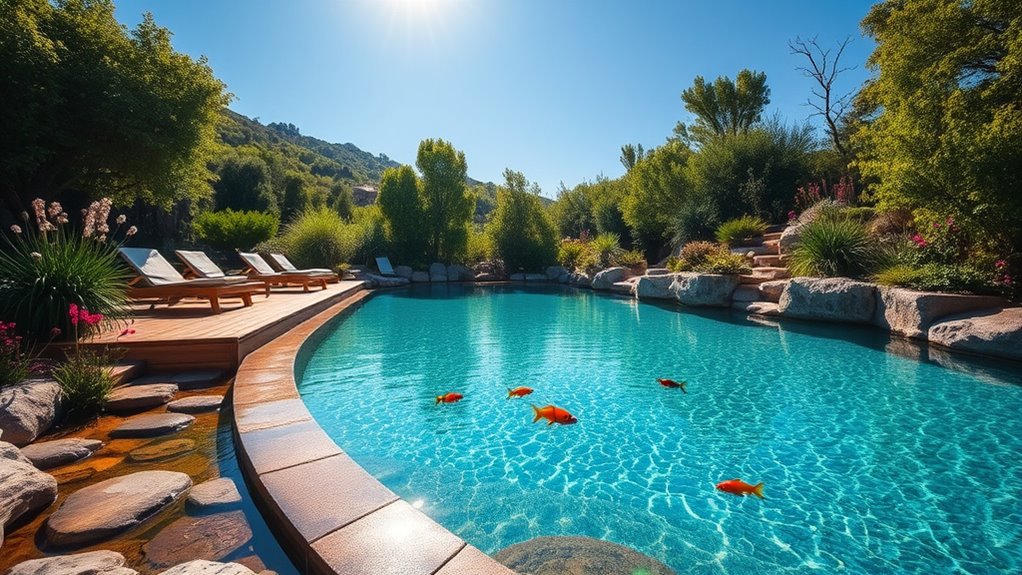
When you choose a natural swimming pool, you’re not just opting for a unique swimming experience; you’re also investing in your health and well-being.
You’ll swim in a chemical-free environment, protecting your skin and hair from irritation and dryness. If you have sensitivities or allergies, you’ll find this safer swimming option incredibly beneficial.
The serene, natural setting helps reduce stress and fosters a deeper connection to nature, enhancing your overall quality of life.
Additionally, natural pools create eco-friendly ecosystems that support diverse wildlife while minimizing your ecological footprint.
By eliminating chemicals and reducing energy consumption, you’re making a sustainable choice that benefits both you and the environment.
Enjoy the tranquility and beauty that a natural swimming pool brings!
Essential Design Elements for Natural Pools

Designing a natural swimming pool involves careful consideration of various essential elements that create a harmonious balance between functionality and aesthetics.
You can choose between one-pot and two-pot designs, with the regeneration zone occupying up to half of the pool’s surface area. Efficient water circulation is critical, using submerged pumps to maintain filtration.
Choose between one-pot and two-pot designs, ensuring efficient water circulation with submerged pumps for optimal filtration.
Depth variations should suit both swimming and landscaping needs, ensuring seamless integration with the surrounding environment.
Selecting the right aquatic plants is important; using native species enhances adaptability while aiding in nutrient removal.
For filtration, biological filters made of gravel and plants work effectively.
Finally, prioritize waterproof membranes and aesthetically pleasing materials like brick or porcelain to complete your pool’s design while ensuring durability and beauty.
Integrating Natural Pools With Garden Landscapes

Integrating natural swimming pools into your garden landscape not only enhances the visual appeal but also creates a cohesive outdoor environment.
By blending water features with lush vegetation, you achieve a holistic approach that promotes ecological balance. Incorporating natural materials like wood decking and boulders erases the boundaries between man-made structures and nature, while vibrant plant borders add color and life.
This integration fosters diverse ecosystems, providing habitats for wildlife and microorganisms. Additionally, strategic placement improves water quality and reduces maintenance by utilizing natural filtration processes.
With customizable designs, you can tailor your natural pool to suit your unique landscape, ensuring a beautiful, functional, and sustainable outdoor retreat.
Enjoy the serenity of a space that truly reflects nature’s beauty.
Maintenance Tips for Natural Swimming Pools
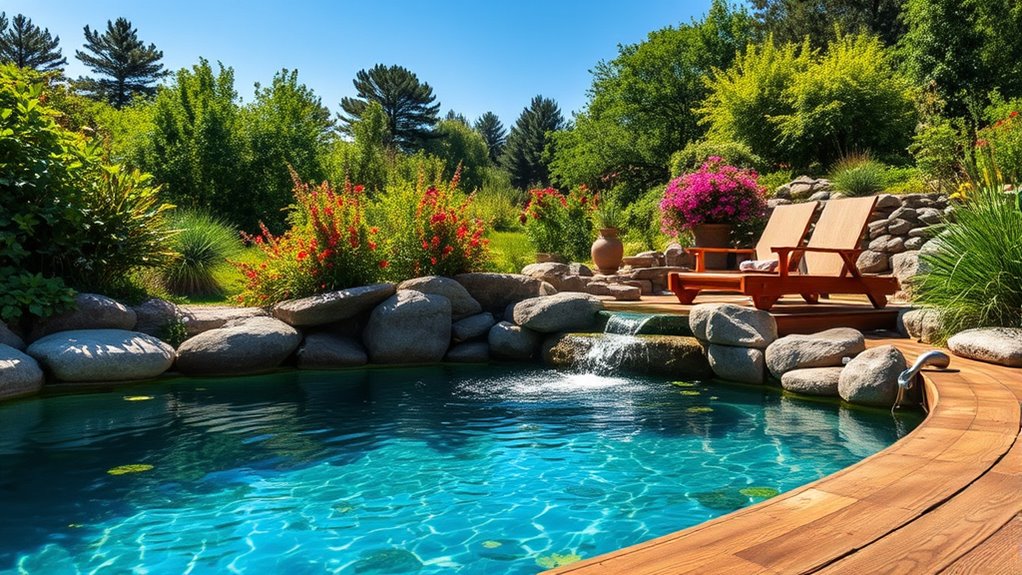
While maintaining a natural swimming pool may seem intimidating, it’s actually simpler than you might think. These pools rely on biological filters instead of chemicals, making upkeep easier.
Regularly net out debris and use a pond vacuum during spring cleaning to keep your pool tidy. Annual spring cleaning is vital to prevent algae blooms; adding beneficial bacteria to the filters enhances water purification.
Monitor water temperature to avoid unwanted growth, and consider using pond dye in warmer months. Don’t forget to inspect your plumbing and equipment regularly to guarantee everything’s functioning well.
Adjust pump settings seasonally to conserve energy and maintain efficiency. With these tips, your natural swimming pool will thrive with minimal effort.
Enhancing Aesthetics With Natural Features

Maintaining a natural swimming pool not only guarantees its cleanliness but also sets the stage for enhancing its aesthetics with natural features.
You can create a seamless integration with your landscape by using stone-lined edges and incorporating irregular shapes that mimic ponds or lakes. Sloping entries allow for a more organic look, while surrounding your pool with native aquatic plants like water lilies and rushes adds beauty and supports the ecosystem.
Consider adding rocks and waterfalls for visual appeal, and don’t forget shallow shelves for lounging and plant integration.
Environmental Benefits of Natural Swimming Pools
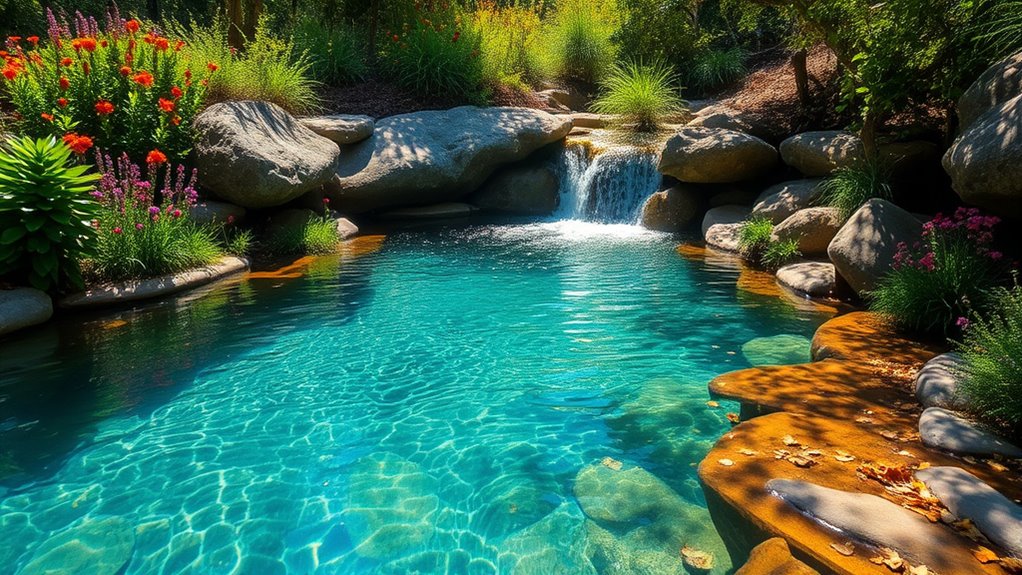
Natural swimming pools offer a range of environmental benefits that make them a smart choice for eco-conscious homeowners. By using biological filtration instead of harsh chemicals, you protect local wildlife and promote biodiversity in your backyard.
These pools minimize chemical runoff, safeguarding surrounding plants and animals from pollution. Their natural filtration systems enhance water quality while reducing energy consumption compared to traditional pools.
You’ll create a balanced ecosystem that thrives without the ecological footprint associated with chlorine production. Plus, natural pools integrate seamlessly into their surroundings, supporting a variety of aquatic life.
Choosing a natural swimming pool not only provides a safer swimming experience but also reflects your commitment to a healthier environment.
Innovative Concepts for Natural Swimming Pool Construction

As you begin creating your own natural swimming pool, consider how innovative design concepts can transform your outdoor space into a serene oasis.
Integrating natural stone like granite not only enhances beauty but also complements modern technology. You can mimic traditional pools or create unique shapes to suit your yard’s layout.
Incorporating native plants helps maintain water quality while preventing erosion. Employ biological filtration zones with reeds and duckweed for natural purification, and consider low-consumption pumps to keep energy use minimal.
Use locally sourced materials for construction, ensuring your pool harmonizes with its environment.
Frequently Asked Questions
How Much Does a Natural Swimming Pool Typically Cost?
A natural swimming pool typically costs between $60,000 and $80,000, with an average around $70,000 for a basic setup.
Depending on the size, materials, and features you choose, prices can range from $50,000 to $150,000.
While the initial investment is higher than traditional pools due to complex designs, you’ll find maintenance costs are usually lower, and you’ll enjoy an eco-friendly, beautiful swimming experience in your backyard.
Can Natural Pools Be Heated for Year-Round Use?
Imagine your natural pool as a vibrant garden, flourishing year-round.
Yes, you can heat natural pools for year-round use! Using methods like solar heating or heat pumps, you can extend your swimming season and enjoy consistent temperatures.
Just remember, it’s essential to maintain the ecosystem’s balance. By choosing energy-efficient, eco-friendly options, you keep your pool a serene oasis while diving into comfort and enjoyment throughout every season.
Are There Specific Plants Recommended for the Regeneration Area?
For your regeneration area, you’ll want to include a variety of plants to guarantee effective water cleaning.
Consider adding water lilies for beauty and balance, cattails for structural support, and American lotus plants for a vibrant ecosystem.
Pickerelweed helps with submerged growth, while common waterweed and hornwort boost oxygen levels.
How Long Does It Take to Build a Natural Swimming Pool?
Ever wonder how long it takes to build a natural swimming pool?
Well, it typically takes anywhere from a few weeks to several months, depending on various factors.
You’ll start with design and planning, then gather materials and prepare the site.
Excavation and construction follow, which can be influenced by weather and complexity.
Once it’s built, expect additional time for landscaping and establishing a balanced ecosystem.
Patience is key, but the results are worth it!
What Wildlife Might Be Attracted to a Natural Swimming Pool?
A natural swimming pool can attract a variety of wildlife.
You might see dragonflies and damselflies hunting mosquitoes, while butterflies and bees visit nearby flowers.
Frogs and toads could call your pool home, and small fish may occasionally swim by.
Birds and even hummingbirds might stop for a drink, while rabbits and squirrels enjoy the surrounding garden.
Creating a welcoming environment encourages this diverse ecosystem, enhancing your outdoor experience.
Conclusion
Incorporating a natural swimming pool into your outdoor space not only enhances your landscape but also promotes eco-friendliness. As the saying goes, “Nature does not hurry, yet everything is accomplished.” By choosing a natural pool, you’re embracing an environment that encourages relaxation and harmony. With the right design elements and maintenance, you can create a serene oasis that blends seamlessly with your garden. Immerse yourself in the beauty of nature and enjoy the many benefits that come with it!


